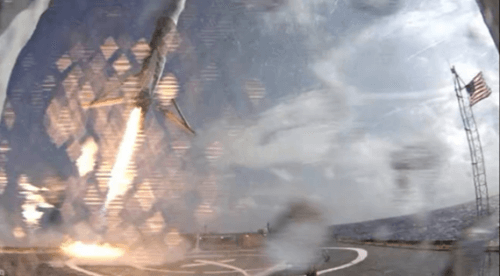Elon Musk, CEO and President of SpaceX wrote on Twitter: "SpaceX will continue to try to make a soft landing and reuse the first stage of the rocket in future launches as well"

After a 24-hour delay due to threatening cloud cover, SpaceX's Falcon 9 rocket lifted off to orbit from Florida's Space Coast, carrying scientific supplies destined for the International Space Station in a Dragon spacecraft.
Meanwhile, SpaceX's valiant attempt to land and retrieve the first stage of the Falcon 9 rocket, which is as tall as a 14-story building, failed. The launcher did reach exactly the point it aimed for, a small rig in the heart of the Atlantic Ocean, but the rig wobbled, the missile hit it and fell and exploded.
Elon Musk, CEO and President of SpaceX wrote on Twitter: "SpaceX will continue to try to make a soft landing and reuse the first stage of the rocket in subsequent launches as well, which is a secondary goal for the company (the main goal is of course sending the cargo spacecraft to the space station). SpaceX released photos and a video clip of the landing attempt.
"Looks like (the first stage of a rocket) Falcon landed OK, but too high lateral speed caused it to flip after landing," Musk tweeted.
The first stage of the Falcon 9 launcher in the final moments of the hard landing on the rig in the Atlantic Ocean after the CRS-6 launch, photo: SpaceX
The launcher is equipped with four legs and a grid of fins to enable it to try the class.
An observation plane filmed a dramatic video of the landing on the rig known as 'autonomous spaceport drone ship' (ASDS). The rig was placed about 350-400 kilometers from the coast of Carolina in the Atlantic Ocean along the missile's flight path towards the North East coast of the USA to match its orbit to that of the International Space Station. This is a very small rig, not much wider than the bottom of the missile.

5 תגובות
Hmmm from what I understand the Commonwealth Treasury government doesn't let them land on the ground until it has been proven safe.
Pine, wind waves and other kinds of vegetation make the landing much more difficult than a simulation or even a controlled experiment, don't forget that most of the time it is actually hardware problems that fail these landings (like the last time)
It seems to me that the problem is not the size of the surface but a strong oscillation towards the touch that required a last minute correction from the steering system, a crude and too late correction for such a large body with great inertia. Landing on land is simpler but not possible from Florida and from there the commercial launches are made
The final approach speed is also fast compared to the previous tests in the launch phase, they may not have fuel reserves to slow the approach
And why the insistence on landing a small and unstable rig in the middle of the sea? Are there any isolated places on the ground that you can land on? Why is there a surface in the middle of the sea, what is the logic here?
It is not clear to me why they take such small safety margins, according to the video it seems that the rocket descends at a really high speed and begins to slow down just before hitting the surface, why not descend in a slower and more gradual manner that also allows for more control? Also the landing surface according to what I understood is really small and leaves hardly any room for error, about a meter on each side of the landing feet, why not create a larger surface that does not require precision to the millimeter during landing?
All in all, such a landing does not seem like such a complicated thing to me, it's the first and second part of physics, I remember a computer game I played about 30 years ago of a similar simulation of a missile landing on a landing pad, so it's true that it's not a computer game, but still the principles are Physical forces are quite simple and I don't understand why it should be so complicated.
Better video:
https://www.youtube.com/watch?v=BhMSzC1crr0&hc_location=ufi